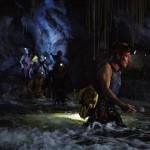Sanctum: VFX, a wet, dark challenge
 David Booth, VFX supervisor on Sanctum, discusses the challenges of shooting both in caves and underwater, while doing it all in stereoscopic 3D.
David Booth, VFX supervisor on Sanctum, discusses the challenges of shooting both in caves and underwater, while doing it all in stereoscopic 3D.
I was involved from pre-production right through to final VFX delivery, which gave me latitude in how the sets were prepared and what requirements were necessary for post. With most of the shots in darkness, we had to adjust our lighting to cover exposure for the green screens and also the foreground images. This enabled better keying and gave us a better range for grade matching.
In terms of visual effects, we needed to add, extend, or completely replace environments to look exactly the same as those shot on set and locations. We employed the talents of Iloura to undertake the 200+ VFX shots, with the company adding to the environments and also taking on a few extra special shots; all CG cave environments required rock structures that matched into those used on set. These also required dripping water, atmosphere and, if we were close to the surface, birds. On a number of wide shots, we decided to go the whole CG route and added animated characters that represented the actors in these environments.
We built full ‘cave’ sets to allow us flexibility with moving the camera around freely, and also place a green screen in position where required. We had constant technical coverage of all shots, and camera alignment was checked regularly. Interocular distance and convergence were also checked live and adjusted per shot. We used beam splitters for the main ‘on land’ photography, and a side-by-side rig for underwater photography and helicopter plates, but the rig restricted us from doing close-up shots and keeping convergence correct at the same time. I was able to reconverge the shots without any degradation or rescaling, even with a 10 cm offset between the two lenses. This was a unique challenge and I’m very pleased with the results.
I was able to build my own rig, small enough to use in an underwater housing, but needed so that we could get close-ups. I had a beam splitter built using two modified Nikon D3S cameras with an adjustable base plate for alignment. It was mounted in an underwater housing and tests proved promising; the camera is still in development.



